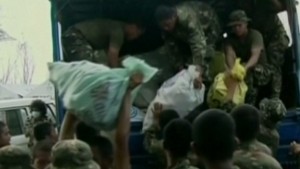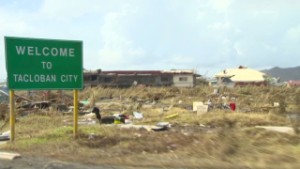Projected Typhoon Haiyan death toll falls, but tensions rise amid aid bottlenecks
Cebu, Philippines (CNN) — While still unimaginably devastating, Typhoon Haiyan may not turn out to be as deadly as initially thought, the president of the Philippines told CNN’s Christiane Amanpour Tuesday.
The initial projection of 10,000 deaths now appears to be “too much” and the final toll is more likely to be in the range of 2,000 to 2,500, President Benigno Aquino III said.
The official death toll stood at 1,774 on Tuesday, which would suggest Aquino believes a little more than 700 bodies remain unaccounted for.
While welcome, the revised projection is of little consolation to survivors of the storm, which flattened portions of the country and left tens of thousands homeless.
 Photos: Haiyan’s wrath from above
Photos: Haiyan’s wrath from above Damaged roads, airports slow storm relief
Damaged roads, airports slow storm relief
 Storm survivors desperate for aid
Storm survivors desperate for aid
 The road to Tacloban
The road to Tacloban
Amid widespread suffering and reports of rising tensions on the ground, aid organizations and nations around the world raced Tuesday to deliver aid to areas devastated by the storm four days ago.
While continued rain and transportation problems were stymieing efforts to deliver aid to those in need, Doctors Without Borders was one of many international organizations deploying cargo flights with hundreds of tons of supplies on board.
Among the gear: tetanus vaccinations, hygiene kits, tents and even an inflatable hospital to treat badly wounded people staggering into Tacloban’s shattered airport seeking treatment.
In Hong Kong, the U.S. Navy rounded up sailors enjoying shore leave from the USS George Washington and ordered the aircraft carrier’s strike group to make “best speed” for the Philippines. Its air wings will deliver supplies and medical care to survivors.
The U.S. Navy was also prepping three amphibious assault ships to head for the region, a senior Pentagon official told CNN. Among other things, such ships can turn seawater into desperately needed potable water.
Despite the efforts, precious little aid was reaching victims Tuesday, especially those in hard-to-reach remote locations.
“Everything, everything’s gone,” a resident in Guiuan — the first city hit by the storm — told CNN on Tuesday. “So we need help.”
Rain from a tropical depression Tuesday grounded some relief flights, while blocked roads and poor conditions at some airports made delivering other aid a difficult proposition — increasing the misery of survivors and raising tensions on the ground, the office of the United Nations High Commissioner for Refugees said Tuesday.
“Women and children are begging on the streets for donations, exposing themselves to abuse and exploitation,” the agency said in a statement. “With power lines still down, the lack of lighting has made women and children at home and in evacuation centres more vulnerable, especially at night.”
More than 2 million people need food aid, the Philippine government said. Nearly 300,000 of them are pregnant women or new mothers.
Tomoo Hozumi, the Philippines’ UNICEF representative, said food, shelter, clean water and basic sanitation were “in a severe shortage.”
“The situation on the ground is very hideous,” he told CNN’s “The Situation Room.”